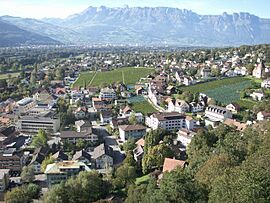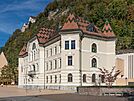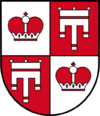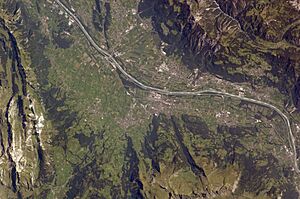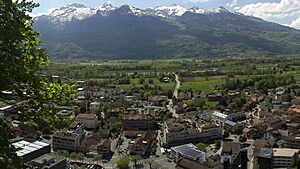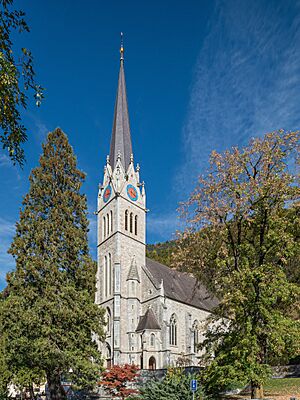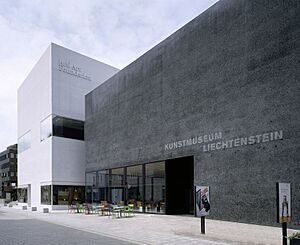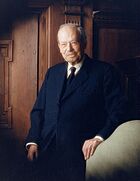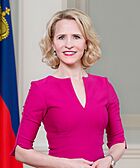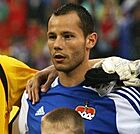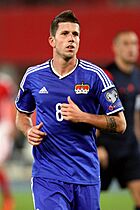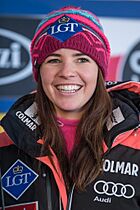Vaduz facts for kids
Quick facts for kids
Vaduz
|
|||
|---|---|---|---|
|
Capital city and municipality
|
|||
|
Panoramic, Government building, Castle of Vaduz, Tre Cavalli (literally Three Horses) sculpture, Rotes Haus (literally Red House), Cathedral of St. Florin, Liechtenstein Museum of Fine Arts, House of Parliament
|
|||
|
|||
|
Location of Vaduz
|
|||
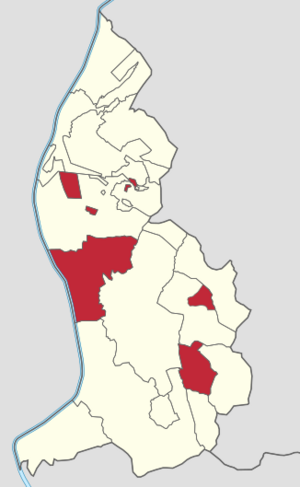
Vaduz and its exclaves in Liechtenstein
|
|||
| Country | |||
| Electoral district | Oberland | ||
| Villages | Ebenholz, Mühleholz | ||
| Area | |||
| • Total | 17.28 km2 (6.67 sq mi) | ||
| Elevation | 455 m (1,493 ft) | ||
| Population
(31-12-2019)
|
|||
| • Total | 5,696 | ||
| • Density | 329.63/km2 (853.7/sq mi) | ||
| Time zone | UTC+1 (CET) | ||
| • Summer (DST) | UTC+2 (CEST) | ||
| Postal code |
9490
|
||
| Area code(s) | 7001 | ||
| ISO 3166 code | LI-11 | ||
| Website | www.vaduz.li | ||
Vaduz is the capital city of Liechtenstein. It is also where the country's parliament, the national parliament, meets. This city is located along the Rhine River. About 5,696 people live there.
The most famous landmark in Vaduz is Vaduz Castle. It sits high up on a steep hill overlooking the city. This castle is the home of the ruling prince of Liechtenstein and his family. Other important buildings show off the city's unique architecture. These include the Cathedral of St. Florin, the Government House, and the City Hall. You can also find the National Art Gallery and the National Museum here. Even though Vaduz is well-known around the world, it is not the biggest town in Liechtenstein. The nearby town of Schaan has more people.
Contents
What Does the Name Vaduz Mean?
The name Vaduz was first written down as de Faduzes. Like many towns in the Rhine Valley, its name comes from a Romance language. It can be traced back to an old word, auadutg. This word means "aqueduct" and comes from the Latin word aquaeductus.
A Brief History of Vaduz
Vaduz is first mentioned in old writings from the 12th century as Faduzes. In 1322, the castle was first noted. Swiss forces attacked and destroyed the castle and the entire city in 1499 during the Swabian War.
How Liechtenstein Became a Principality
In the 1600s, the Liechtenstein family wanted a seat in the Imperial diet, which was like a big meeting of rulers. To get a seat, they needed to own land that was directly under the Holy Roman Emperor. This meant no other feudal lord could have rights over the land.
The family really wanted this power. So, they bought two small areas: the Lordship of Schellenberg in 1699 and the countship of Vaduz in 1712. These lands had exactly the right political status.
On January 23, 1719, after these purchases, Charles VI, Holy Roman Emperor, declared that Vaduz and Schellenberg were joined together. He made them a Fürstentum (a principality) and named it "Liechtenstein." This was done to honor his "true servant," Anton Florian of Liechtenstein. On this day, Liechtenstein became an independent member of the Holy Roman Empire. Interestingly, the Princes of Liechtenstein did not visit their new principality for over 120 years!
How Vaduz is Governed
Vaduz is managed by its mayor and a council of 12 people. These officials are chosen every four years. The current mayor is Florian Meier. He was elected in 2024.
Vaduz's Climate
Vaduz has an oceanic climate. This means it has warm summers and cool winters. The city gets more rain in the summer, but it rains a bit throughout the year. On average, Vaduz receives about 900 millimeters (35 inches) of rain each year.
The warmest month is July. High temperatures average around 25°C (77°F), and low temperatures are about 14°C (57°F). January is the coldest month. Highs average 3°C (37°F), and lows are around -3°C (27°F).
What to See in Vaduz
Vaduz Castle is the home of the ruling prince of Liechtenstein. You can see the castle from almost anywhere in Vaduz. It sits on a steep hill in the middle of the city.
The Cathedral of St. Florin, Government House, and City Hall show different building styles from various time periods.
Museums and Art
The National Art Gallery and the National Museum are both in Vaduz.
- The National Art Gallery, also called Kunstmuseum Liechtenstein, displays modern and contemporary art. It also shows pieces from the private collection of the princely family. The building itself is a famous piece of architecture. It was finished in 2000 and looks like a "black box" made of dark concrete and black stone.
- The Liechtenstein National Museum has a permanent exhibit about Liechtenstein's culture and nature. It also hosts special exhibits.
- You can also visit the Postage Stamp Museum and a Ski Museum.
People of Vaduz
As of 2019, 5,696 people lived in Vaduz. About 42% of the people living in the city are from other countries. Most of the people in Vaduz (67%) are Roman Catholic. This percentage is even higher for people who are citizens of Liechtenstein (81%). The largest minority religions are Protestantism (10%) and Islam (8%).
Economy and Getting Around
Vaduz has a busy tourism industry. Even so, it is one of the few capital cities in the world without an airport. The closest major airport is in Zürich, Switzerland, about 120 kilometers (75 miles) away.
There are many bus connections to nearby train stations like Buchs, Sargans, and Feldkirch. These buses are run by Liechtenstein Bus.
Vaduz does not have its own train station. However, the Schaan-Vaduz station is one of four train stations in Liechtenstein. It is located in the town of Schaan, just a few kilometers north of Vaduz. This station is on the international train line between Switzerland and Austria.
Education in Vaduz
Vaduz has two primary schools: Äule Primary School and Ebenholz Primary School. Ebenholz Primary School is near the University of Liechtenstein, which is also in the city. Both schools share the same office and management. Where children go to school mostly depends on where they live. There are also four kindergarten locations in Vaduz.
Realschule Vaduz and Oberschule Vaduz are located at the Schulzentrum Mühleholz II in Vaduz. The Liechtensteinisches Gymnasium, a high school, is also in Vaduz. Other schools, like Realschule Schaan and Sportschule Liechtenstein, are in the nearby town of Schaan.
Famous People from Vaduz
Many notable people have connections to Vaduz.
- Alois, Hereditary Prince of Liechtenstein (born 1968) – He has been the regent of Liechtenstein since 2004.
- Franz Joseph II, Prince of Liechtenstein (1906–1989) – He was the ruling Prince of Liechtenstein from 1938 until his death. He was the first prince to live full-time in the principality.
- Hans-Adam II, Prince of Liechtenstein (born 1945) – He is the current monarch and head of state of Liechtenstein. He lives in Vaduz Castle.
- Marlies Amann-Marxer (born 1952) – A politician who served as Minister of Infrastructure, Environment and Sport.
- Aurelia Frick (born 1975) – A Liechtenstein politician who served as Minister of Foreign Affairs, Education, and Culture.
- Josef Rheinberger (1839–1901) – A famous organist and composer.
Footballers from Vaduz
Many footballers who have played for the Liechtenstein national team come from Vaduz:
- Ronny Büchel (born 1982) – Played 72 games for the national team.
- Sandro Wieser (born 1993) – A professional footballer who has played 47 games for the national team.
- Nicolas Hasler (born 1991) – A professional footballer who has played 55 games for the national team.
- Rainer Hasler (1958–2014) – A defender chosen as the country's Golden Player by the Liechtenstein Football Association.
Other Athletes from Vaduz
- Tina Weirather (born 1989) – A World Cup alpine ski racer.
- Stephanie Vogt (born 1990) – A retired professional tennis player.
- Fabienne Wohlwend (born 1997) – A racing driver.
Images for kids
See also
 In Spanish: Vaduz para niños
In Spanish: Vaduz para niños


